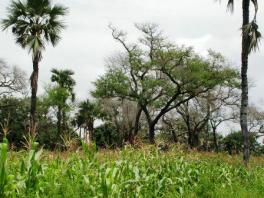 What is agroforestry? According to the USDA National Agroforestry Center (NAC), it is a practice that “intentionally combines agriculture and forestry to create integrated and sustainable land-use systems. Agroforestry takes advantage of the interactive benefits from combining trees and shrubs with crops and/or livestock.” It seems the approach has not only the obvious ecological benefits of diminishing greenhouse gas emissions and the destruction of biodiversity through land-clearing, but farms using the technique actually benefit from the presence of additional trees and shrubs. Practices encourage symbiotic, ecological relationships resulting in:
What is agroforestry? According to the USDA National Agroforestry Center (NAC), it is a practice that “intentionally combines agriculture and forestry to create integrated and sustainable land-use systems. Agroforestry takes advantage of the interactive benefits from combining trees and shrubs with crops and/or livestock.” It seems the approach has not only the obvious ecological benefits of diminishing greenhouse gas emissions and the destruction of biodiversity through land-clearing, but farms using the technique actually benefit from the presence of additional trees and shrubs. Practices encourage symbiotic, ecological relationships resulting in:
- Enhanced soil fertility and livestock productivity on farms;
- Linking poor households to markets for high-value fruits, oils and medicines;
- Improved productivity and the sustainable management of natural resources;
- Maintaining or enhancing the supply of environmental resources such as water, soil health, carbon sequestration and biodiversity.
Granted such systems will require a delicate balance and selection of crop and tree species and it may not work everywhere. But if the most arid regions of Africa have been advised to use agroforestry as way of reversing desertification and improve livelihood for smallholder farmers, it is certainly something that deserves attention. Especially in light of the recent food crisis, and the projection of continued high food prices for the coming decade, agricultural innovations targeting small-holder farmers and sustainable farming will be essential. If an approach can help improve crop yield by providing natural fertilizer, increase income and begin to reverse the effects of extensive agriculture – a major source of CO2 emissions and loss of ecological diversity – then what are we waiting for?
THP works to increase the capacity of our farming partners with similarly environmentally friendly techniques such as microdosing, the application of small quantities of fertilizer to enhance efficiency and improve crop yields. Meet Delma Jean, a small-holder farmer in Burkina Faso, who used cost-effective, eco-friendly microdosing techniques to increase his income and send his children to school.
Learn More:
- Check out the work of the World Agroforestry Center.
Topic submitted by THP-intern Heidi Chan
photo credit: Agroforestry in Burkina Faso via Wikipedia Commons
